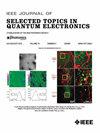A Two-Way Analysis of Brain Synchrony: Assessing Brain-Event Relationships Using Information Metrics
IF 5.1
2区 工程技术
Q1 ENGINEERING, ELECTRICAL & ELECTRONIC
IEEE Journal of Selected Topics in Quantum Electronics
Pub Date : 2025-06-23
DOI:10.1109/JSTQE.2025.3582203
引用次数: 0
Abstract
Functional near-infrared spectroscopy (fNIRS) is well-suited for hyperscanning in naturalistic situations, offering significant potential for assessing social brain function in everyday life. Previous studies have reported inter-brain synchrony during social interactions and sought to explore its mechanisms by correlating behavioral events with brain signals. However, commonly used regression analyses, such as Generalized Linear Models (GLM), rely on target events hypothesized as explanatory variables. This reliance introduces a dependency on the researcher’s assumptions, which can compromise replicability in social neuroscience. While such dependency may be less problematic in strictly controlled experimental paradigms focused on specific hypotheses, it poses significant challenges in naturalistic experiments like social interactions, where numerous events and signals may serve as potential explanatory variables. To address this limitation, we introduced a new approach: signed-normalized mutual information for wavelet transform coherence (WTC-sNMI). This method enables a two-way analysis to evaluate relationships between event sequences and brain synchrony. Through simulations and real-data applications, we evaluated the performance of the proposed method. The results showed that WTC-sNMI analysis performed comparably to regression analysis in detecting both inter-brain synchrony and within-brain synchrony (i.e., brain connectivity). Moreover, applying WTC-sNMI to a tapping dataset revealed the expected patterns of synchrony between the lateral sides of the motor area. These findings validate the effectiveness of WTC-sNMI as a robust two-way analytical tool for studying brain-event relationships.脑同步的双向分析:利用信息度量评估脑-事件关系
功能近红外光谱(fNIRS)非常适合在自然情况下进行超扫描,为评估日常生活中的社会大脑功能提供了重要的潜力。先前的研究报道了社会互动过程中的脑间同步,并试图通过将行为事件与大脑信号相关联来探索其机制。然而,常用的回归分析,如广义线性模型(GLM),依赖于假设的目标事件作为解释变量。这种依赖引入了对研究者假设的依赖,这可能会损害社会神经科学的可重复性。虽然这种依赖关系在专注于特定假设的严格控制的实验范式中可能没有那么大的问题,但它在社会互动等自然主义实验中构成了重大挑战,在这些实验中,许多事件和信号可能作为潜在的解释变量。为了解决这一限制,我们引入了一种新的方法:小波变换相干性的签名归一化互信息(WTC-sNMI)。这种方法能够进行双向分析,以评估事件序列和大脑同步之间的关系。通过仿真和实际数据应用,对该方法的性能进行了评价。结果表明,WTC-sNMI分析在检测脑间同步和脑内同步(即脑连通性)方面的效果与回归分析相当。此外,将WTC-sNMI应用于敲击数据集揭示了运动区域外侧之间的预期同步模式。这些发现验证了WTC-sNMI作为研究脑-事件关系的强大双向分析工具的有效性。
本文章由计算机程序翻译,如有差异,请以英文原文为准。
求助全文
约1分钟内获得全文
求助全文
来源期刊

IEEE Journal of Selected Topics in Quantum Electronics
工程技术-工程:电子与电气
CiteScore
10.60
自引率
2.00%
发文量
212
审稿时长
3 months
期刊介绍:
Papers published in the IEEE Journal of Selected Topics in Quantum Electronics fall within the broad field of science and technology of quantum electronics of a device, subsystem, or system-oriented nature. Each issue is devoted to a specific topic within this broad spectrum. Announcements of the topical areas planned for future issues, along with deadlines for receipt of manuscripts, are published in this Journal and in the IEEE Journal of Quantum Electronics. Generally, the scope of manuscripts appropriate to this Journal is the same as that for the IEEE Journal of Quantum Electronics. Manuscripts are published that report original theoretical and/or experimental research results that advance the scientific and technological base of quantum electronics devices, systems, or applications. The Journal is dedicated toward publishing research results that advance the state of the art or add to the understanding of the generation, amplification, modulation, detection, waveguiding, or propagation characteristics of coherent electromagnetic radiation having sub-millimeter and shorter wavelengths. In order to be suitable for publication in this Journal, the content of manuscripts concerned with subject-related research must have a potential impact on advancing the technological base of quantum electronic devices, systems, and/or applications. Potential authors of subject-related research have the responsibility of pointing out this potential impact. System-oriented manuscripts must be concerned with systems that perform a function previously unavailable or that outperform previously established systems that did not use quantum electronic components or concepts. Tutorial and review papers are by invitation only.
 求助内容:
求助内容: 应助结果提醒方式:
应助结果提醒方式:


